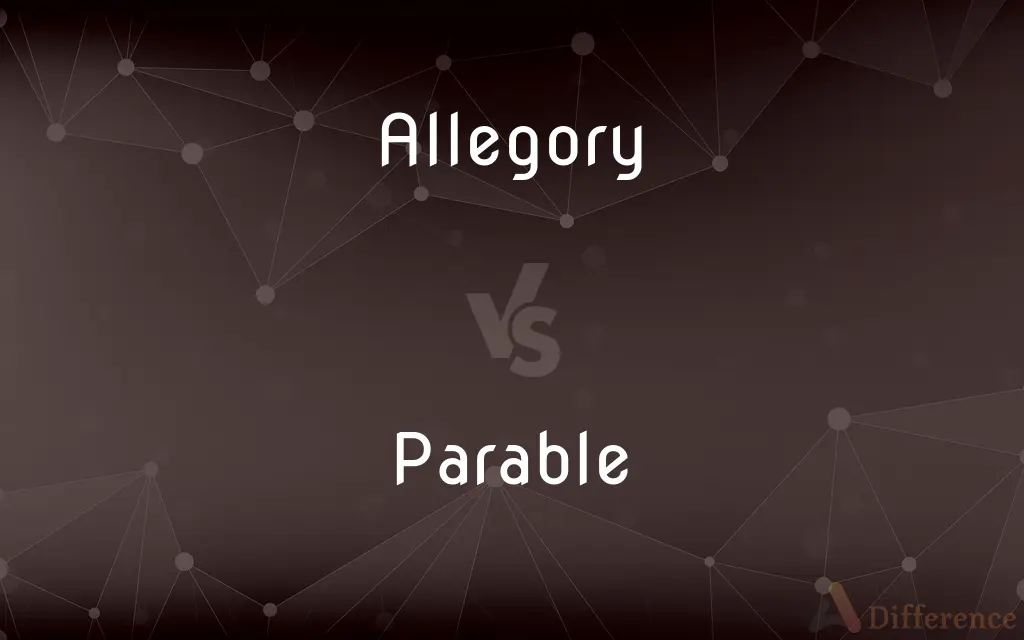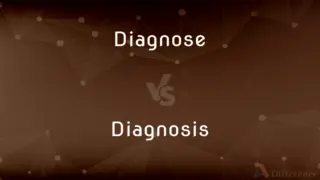Allegory vs. Parable — What's the Difference?
By Tayyaba Rehman — Updated on October 3, 2023
An allegory is a symbolic story or representation conveying a complex, abstract idea, while a parable is a simple, illustrative story teaching a moral or spiritual lesson.

Difference Between Allegory and Parable
Table of Contents
ADVERTISEMENT
Key Differences
An allegory is a narrative or depiction in which characters, events, and settings symbolize deeper abstract meanings, whereas a parable is a succinct narrative that uses relatable situations to convey a moral lesson.
Allegories often have a broader scope, sometimes spanning entire novels or works, while parables tend to be shorter and more focused on a singular message.
Within allegories, it's common to find intricate layers of symbolism that work together to relay a complex message or theme. In contrast, a parable's strength lies in its simplicity and the clarity of its moral instruction.
While both allegories and parables aim to teach or convey deeper truths, allegories are often more open to interpretation, relying on the audience to discern their nuanced meanings. Parables, however, generally present their lessons more directly, aiming for immediate understanding.
Historically, parables have been commonly used in religious texts to elucidate spiritual truths, while allegories can be found across various genres and are not limited to religious contexts.
ADVERTISEMENT
Comparison Chart
Definition
Symbolic representation of abstract ideas or principles
Short story illustrating a moral or spiritual lesson
Length/Complexity
Often longer with layered symbolism
Typically short and straightforward
Interpretation
Open to deeper interpretation
Clear moral lesson with limited interpretation
Usage
Found across various genres
Common in religious texts
Message Delivery
Through intricate symbols and characters
Through relatable situations and clear lessons
Compare with Definitions
Allegory
Representation of abstract principles through symbolic characters.
Dante's Inferno is an allegory of the soul's journey towards God.
Parable
A simple story illustrating a moral lesson.
The parable of the prodigal son teaches about forgiveness and redemption.
Allegory
Artistic expression illustrating deeper truths through symbols.
The painting served as an allegory for the struggles of mankind.
Parable
An illustrative tale to guide moral or ethical behavior.
The parable of the sower explains the effects of receptivity to truth.
Allegory
A story where characters and events symbolize deeper meanings.
Animal Farm is an allegory for the Russian Revolution.
Parable
A brief narrative delivering a spiritual message.
Many biblical teachings are conveyed through parables.
Allegory
A narrative employing extensive symbolic representation.
The cave allegory in Plato's Republic represents ignorance and enlightenment.
Parable
An easily understood story with a clear moral teaching.
The parable reminded listeners of the value of honesty.
Allegory
Fictional work conveying a philosophical or moral truth.
The Lord of the Flies is an allegory about the inherent evil in humans.
Parable
A short, fictional story conveying a singular truth or lesson.
He shared a parable about the importance of perseverance.
Allegory
As a literary device, an allegory is a narrative in which a character, place, or event is used to deliver a broader message about real-world issues and occurrences. Authors have used allegory throughout history in all forms of art to illustrate or convey complex ideas and concepts in ways that are comprehensible or striking to its viewers, readers, or listeners.
Parable
A parable is a succinct, didactic story, in prose or verse, that illustrates one or more instructive lessons or principles. It differs from a fable in that fables employ animals, plants, inanimate objects, or forces of nature as characters, whereas parables have human characters.
Allegory
A story, poem, or picture that can be interpreted to reveal a hidden meaning, typically a moral or political one
Pilgrim's Progress is an allegory of the spiritual journey
Parable
A simple story used to illustrate a moral or spiritual lesson, as told by Jesus in the Gospels
The parable of the blind men and the elephant
A modern-day parable
Allegory
The representation of abstract ideas or principles by characters, figures, or events in narrative, dramatic, or pictorial form.
Parable
A simple story illustrating a moral or religious lesson.
Allegory
A story, picture, or play employing such representation. John Bunyan's Pilgrim's Progress and Herman Melville's Moby-Dick are allegories.
Parable
A short narrative illustrating a lesson (usually religious/moral) by comparison or analogy.
In the New Testament the parables told by Jesus Christ convey His message, as in "The parable of the prodigal son".
Catholic sermons normally draw on at least one Biblical lecture, often parables.
Allegory
A symbolic representation
The blindfolded figure with scales is an allegory of justice.
Parable
(transitive) To represent by parable.
Allegory
(rhetoric) A narrative in which a character, place, or event is used to deliver a broader message about real-world issues and occurrences.
Parable
(obsolete) That can easily be prepared or procured; obtainable.
Allegory
A picture, book, or other form of communication using such representation.
Parable
Procurable.
Allegory
A symbolic representation which can be interpreted to reveal a hidden meaning, usually a moral or political one.
Parable
A comparison; a similitude; specifically, a short fictitious narrative of something which might really occur in life or nature, by means of which a moral is drawn; as, the parables of Christ.
Declare unto us the parable of the tares.
Allegory
A category that retains some of the structure of the category of binary relations between sets, representing a high-level generalisation of that category.
Parable
To represent by parable.
Which by the ancient sages was thus parabled.
Allegory
A figurative sentence or discourse, in which the principal subject is described by another subject resembling it in its properties and circumstances. The real subject is thus kept out of view, and we are left to collect the intentions of the writer or speaker by the resemblance of the secondary to the primary subject.
Parable
A short moral story (often with animal characters)
Allegory
Anything which represents by suggestive resemblance; an emblem.
Parable
(New Testament) any of the stories told by Jesus to convey his religious message;
The parable of the prodigal son
Allegory
A figure representation which has a meaning beyond notion directly conveyed by the object painted or sculptured.
Allegory
A short moral story (often with animal characters)
Allegory
A visible symbol representing an abstract idea
Allegory
An expressive style that uses fictional characters and events to describe some subject by suggestive resemblances; an extended metaphor
Common Curiosities
What's the primary purpose of an allegory?
An allegory aims to convey abstract ideas or principles through symbolic representation in a narrative or art.
Can allegories span entire novels?
Yes, allegories can be as short as a poem or as long as a novel, like George Orwell's "Animal Farm."
Is deciphering an allegory always straightforward?
No, allegories often require deeper contemplation and interpretation to grasp their underlying meanings fully.
How does a parable typically present its message?
A parable delivers its message through a short, illustrative story with a clear moral or spiritual lesson.
How are the lessons in parables usually conveyed?
Parables use relatable situations or characters to convey lessons, making them easily understood by listeners.
Are allegories limited to literary works?
No, allegories can be found in various forms, including visual arts, music, and even architecture.
How do allegories employ symbolism?
Allegories use characters, events, and settings as symbols representing deeper abstract ideas or principles.
Are parables restricted to religious texts?
While parables are common in religious contexts, they can be found in non-religious settings too, serving to convey moral lessons.
Are allegories a modern literary device?
No, allegories have been used for centuries across cultures, like the cave allegory in Plato's "Republic."
Can a story be both an allegory and a parable?
Yes, a story can be both if it employs layered symbolism (allegory) and conveys a clear moral lesson (parable).
Why are parables effective teaching tools?
Parables use familiar and relatable scenarios, making complex lessons easier to understand and remember.
How do parables differ from fables?
While both teach moral lessons, parables often involve human characters and are rooted in realism, whereas fables typically involve animals with human traits.
What differentiates a parable from a regular story?
A parable is designed with the intent of conveying a specific moral or spiritual lesson, unlike regular stories that might not have such a focused message.
What's a well-known allegory in literature?
"The Chronicles of Narnia" by C.S. Lewis is a well-known allegorical series with Christian themes.
Is the interpretation of parables always uniform?
While parables aim for clear lessons, interpretations can vary based on cultural, personal, or contextual differences.
Share Your Discovery

Previous Comparison
Schmuck vs. Putz
Next Comparison
Diagnose vs. DiagnosisAuthor Spotlight
Written by
Tayyaba RehmanTayyaba Rehman is a distinguished writer, currently serving as a primary contributor to askdifference.com. As a researcher in semantics and etymology, Tayyaba's passion for the complexity of languages and their distinctions has found a perfect home on the platform. Tayyaba delves into the intricacies of language, distinguishing between commonly confused words and phrases, thereby providing clarity for readers worldwide.














































